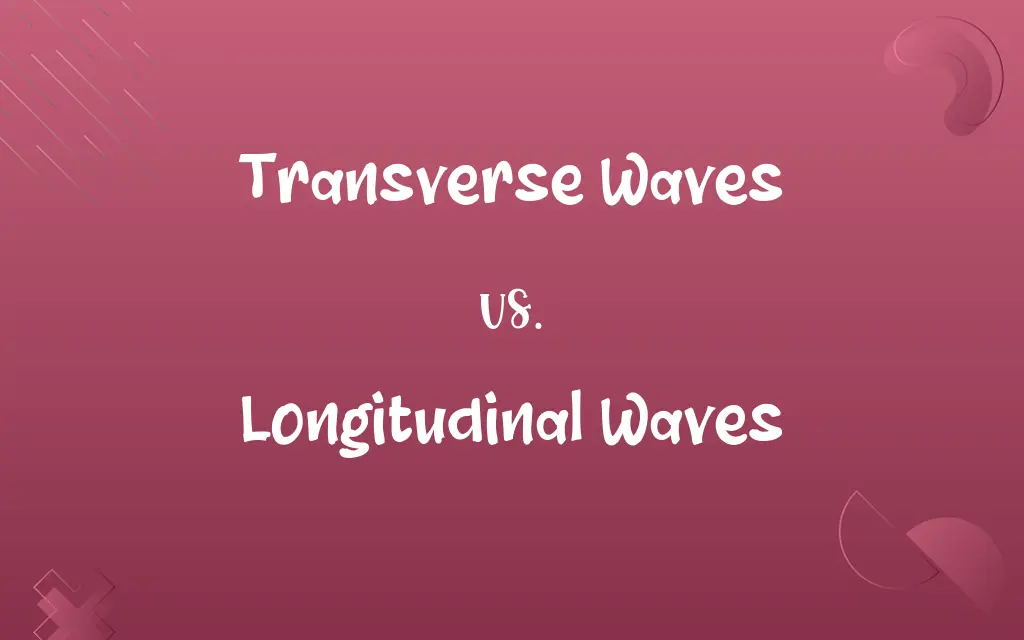Transverse Waves vs. Longitudinal Waves: Know the Difference

By Shumaila Saeed || Published on February 9, 2024
Transverse waves oscillate perpendicular to the direction of energy transfer, while longitudinal waves oscillate parallel to it.

Key Differences
In Transverse Waves, particles of the medium vibrate perpendicular to the direction of wave propagation. Contrarily, in Longitudinal Waves, particles vibrate parallel to the direction of wave travel.
Shumaila Saeed
Feb 09, 2024
Transverse Waves are exemplified by light waves and ripples on water, where motion is perpendicular to wave direction. Conversely, Longitudinal Waves are seen in sound waves and seismic P-waves, with particle motion parallel to wave travel.
Shumaila Saeed
Feb 09, 2024
Transverse Waves are represented by sine or cosine functions, showcasing crests and troughs. Longitudinal Waves, however, are depicted through compressions and rarefactions.
Shumaila Saeed
Feb 09, 2024
Transverse Waves can travel through solids and on liquid surfaces, but not through gases. On the other hand, Longitudinal Waves can propagate through solids, liquids, and gases.
Shumaila Saeed
Feb 09, 2024
Transverse Waves can be polarized due to their perpendicular vibration direction. In contrast, Longitudinal Waves cannot be polarized due to their parallel motion.
Shumaila Saeed
Feb 09, 2024
ADVERTISEMENT
Comparison Chart
Direction of Particle Motion
Perpendicular to wave direction
Parallel to wave direction
Shumaila Saeed
Feb 09, 2024
ADVERTISEMENT
Transverse Waves and Longitudinal Waves Definitions
Transverse Waves
Transverse Waves display amplitude perpendicular to motion direction.
The amplitude of a stadium wave is perpendicular to the direction the wave travels.
Shumaila Saeed
Jan 19, 2024
Longitudinal Waves
Longitudinal Waves have amplitudes parallel to the direction of motion.
The loudness of a sound wave correlates with its amplitude, demonstrating the parallel amplitude of longitudinal waves.
Shumaila Saeed
Jan 19, 2024
Transverse Waves
Transverse Waves involve particles moving perpendicular to wave direction.
Light waves are transverse, as their electric and magnetic fields oscillate perpendicular to their direction.
Shumaila Saeed
Jan 19, 2024
Longitudinal Waves
Longitudinal Waves require a medium for propagation.
Seismic P-waves, as longitudinal waves, travel through Earth’s interior.
Shumaila Saeed
Jan 19, 2024
Transverse Waves
Transverse Waves can be polarized.
Polarized sunglasses block specific transverse wave orientations of sunlight.
Shumaila Saeed
Jan 19, 2024
ADVERTISEMENT
Longitudinal Waves
Longitudinal Waves cannot be polarized.
Sound waves, being longitudinal, cannot be filtered by polarization.
Shumaila Saeed
Jan 19, 2024
Transverse Waves
Transverse Waves do not require a medium for propagation.
Radio waves, a type of transverse wave, can travel through the vacuum of space.
Shumaila Saeed
Jan 19, 2024
Longitudinal Waves
Longitudinal Waves are marked by compressions and rarefactions.
In a slinky wave, coils compress and stretch, demonstrating longitudinal wave characteristics.
Shumaila Saeed
Jan 19, 2024
Transverse Waves
Transverse Waves are characterized by crests and troughs.
Ocean waves exhibit crests and troughs, showcasing their transverse nature.
Shumaila Saeed
Jan 19, 2024
Longitudinal Waves
Longitudinal Waves involve particle motion parallel to wave travel.
Sound waves in air are longitudinal, with air particles vibrating in the same direction as the wave travels.
Shumaila Saeed
Jan 19, 2024
Repeatedly Asked Queries
Do Transverse Waves require a medium to travel?
No, Transverse Waves do not necessarily require a medium; they can propagate through a vacuum.
Shumaila Saeed
Feb 09, 2024
What defines a Transverse Wave?
A Transverse Wave involves particle vibration perpendicular to the direction of wave propagation.
Shumaila Saeed
Feb 09, 2024
What is an example of a Longitudinal Wave?
Sound waves are a common example of Longitudinal Waves.
Shumaila Saeed
Feb 09, 2024
Can Transverse Waves travel through a vacuum?
Yes, Transverse Waves like light and radio waves can travel through a vacuum.
Shumaila Saeed
Feb 09, 2024
What is the main difference in particle motion between Transverse and Longitudinal Waves?
In Transverse Waves, particles move perpendicular to the wave direction; in Longitudinal Waves, they move parallel.
Shumaila Saeed
Feb 09, 2024
How are Transverse Waves represented?
Transverse Waves are typically represented by sine or cosine functions, indicating crests and troughs.
Shumaila Saeed
Feb 09, 2024
Can Transverse Waves be found in everyday life?
Yes, common examples include light waves and electromagnetic waves.
Shumaila Saeed
Feb 09, 2024
What are compressions and rarefactions in Longitudinal Waves?
Compressions are regions of high pressure, and rarefactions are regions of low pressure in a Longitudinal Wave.
Shumaila Saeed
Feb 09, 2024
Why can’t Longitudinal Waves be polarized?
Longitudinal Waves cannot be polarized due to their parallel vibration direction.
Shumaila Saeed
Feb 09, 2024
Are ocean waves Transverse or Longitudinal?
Ocean waves are primarily Transverse, as the water particles move perpendicular to the wave direction.
Shumaila Saeed
Feb 09, 2024
Are seismic waves Transverse or Longitudinal?
Seismic waves include both types; P-waves are Longitudinal, and S-waves are Transverse.
Shumaila Saeed
Feb 09, 2024
Why are light waves not Longitudinal?
Light waves are electromagnetic and oscillate perpendicularly to their direction of travel, making them Transverse.
Shumaila Saeed
Feb 09, 2024
Do Longitudinal Waves have crests and troughs?
No, Longitudinal Waves are characterized by compressions and rarefactions instead of crests and troughs.
Shumaila Saeed
Feb 09, 2024
How does frequency affect Transverse and Longitudinal Waves?
In both wave types, higher frequency means more waves pass a point per unit time, but this doesn't change their fundamental characteristics.
Shumaila Saeed
Feb 09, 2024
What mediums can Longitudinal Waves travel through?
Longitudinal Waves can travel through solids, liquids, and gases.
Shumaila Saeed
Feb 09, 2024
Are sound waves Transverse or Longitudinal?
Sound waves are Longitudinal, as they involve air particles moving parallel to the wave direction.
Shumaila Saeed
Feb 09, 2024
Can Longitudinal Waves travel through outer space?
No, Longitudinal Waves require a medium and cannot travel through the vacuum of space.
Shumaila Saeed
Feb 09, 2024
Can Transverse Waves show interference patterns?
Yes, Transverse Waves like light can interfere, producing patterns of constructive and destructive interference.
Shumaila Saeed
Feb 09, 2024
Is polarization exclusive to Transverse Waves?
Yes, polarization occurs only in Transverse Waves due to their perpendicular vibration direction.
Shumaila Saeed
Feb 09, 2024
How does medium affect the speed of Longitudinal Waves?
The speed of Longitudinal Waves varies with the medium's density and elasticity.
Shumaila Saeed
Feb 09, 2024
Share this page
Link for your blog / website
HTML
Link to share via messenger
About Author
Written by
Shumaila SaeedShumaila Saeed, an expert content creator with 6 years of experience, specializes in distilling complex topics into easily digestible comparisons, shining a light on the nuances that both inform and educate readers with clarity and accuracy.








































































